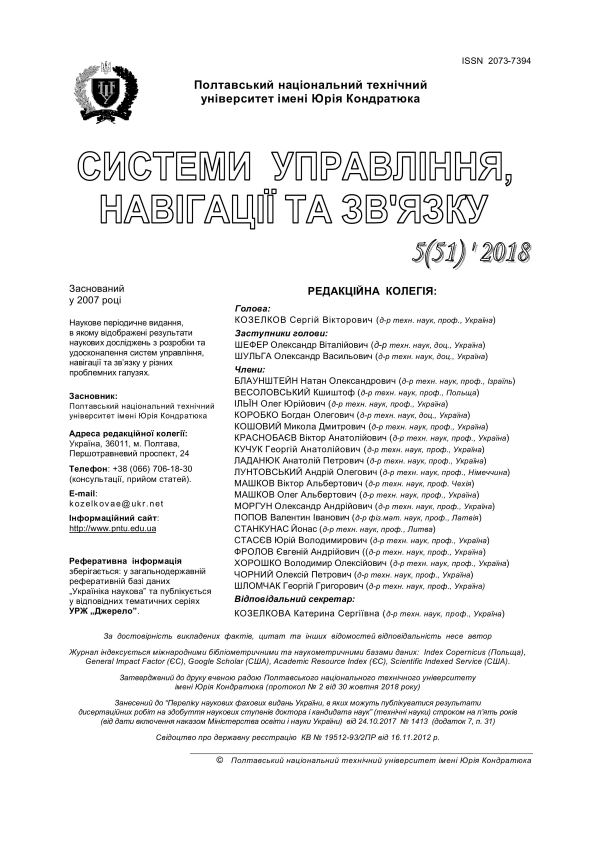INDICATORS AND CRITERIA OF EFFICIENCY EVALUATION OF SAFETY AVIATION COMPLEXES APPLICATION
DOI:
https://doi.org/10.26906/SUNZ.2018.5.008Keywords:
unmanned aviation complexes, military conflicts, performance indicators, specifications, intelligence, criteriaAbstract
Military conflicts of the late XX – early XXI centuries are characterized by the use of a large number of new weapons, which allowed the enemies to distance themselves as far as possible from the direct collision with each other. Unmanned aviation complexes, which during the military conflicts proved their ability to conduct air reconnaissance, damage objects and perform other combat support tasks, became one of the newest examples of weapons on the battlefield. The possibility of successfully solving of various tasks with the help of unmanned aviation complexes was demonstrated during the military conflicts in the Middle East (1982-2008), the Balkans (1999), Afghanistan (2001-2008) and the Caucasus (1994-2008). Nowadays, there is a large number of diverse literature about using unmanned aerial systems during armed conflicts over the past decades. However, the only approach to assessing the effectiveness of using unmanned aviation complexes of special purpose in known sources has not been developed. In this article, the authors proposed indicators and criteria for assessing the effectiveness of using unmanned aviation complexes of special purpose. During the research authors were using the basic provisions of the theory of complex technical systems; method of expert assessments; the method of analysis of hierarchies, methods of multidimensional comparative, general scientific and structural-functional analysis. The indicators and criteria for evaluating the effectiveness of using of special purpose non-pilot aviation complexes, which were proposed in the article, can be used to evaluate the information obtained with equipment operating in the mode of fixed and continuous shooting of individual areas. The indicators proposed in the article can be used for comparative evaluation of several unmanned aviation complexes of special purpose, that allow to assess the level of technical perfection of unmanned aerial systems and choose the most perfect for the implementation of a specific type of task.Downloads
References
Ilyushko, V.M., Mitrakhovich, M.M., Samkov, A.V., Silkov, V.I., Soloviev, O.V., and Strelnikov, V.I (2009). Unmanned aerial vehicles: methods of approximate calculations of basic parameters and characteristics, Kyiv, CSRIAMI of Ukraine, 302 p.
Unmanned vehicles. Handbook (2010). Shephard press, Burnham, 145 p.
Silkov, V. I(1997). Flight dynamics of aircraft. Kyiv, KIUCA, 424 p.
Silkov, V. I (2004). Combat maneuvering of aircraft. Kyiv, NDUU, 338 p.
Pavlushenko, M., Evstafiev, H. and Makarenko, I (2005). Unmanned aerial vehicles: history, application, threat of proliferation and development prospects. Moscow, Human rights, 611 p.
Chepurny, V.A., Bardakov, M.V. and Khudov, G.V(2015). “Analysis of trends in the development and use of reconnaissance unmanned aerial vehicles in modern network-centric and hybrid wars”. Science and Technology of the Air Forces of the Armed Forces of Ukraine. No 4(21)., pp. 24-28.
Ilenko, Ye.Y., Stetshenko, P.M (2016). A mathematical model for estimating the costs of financial resources associated with equipping the Armed Forces with unmanned aerial systems. Science and Technology of the Air Forces of the Armed Forces of Ukraine., No. 3(24), pp. 70-73.
Zharik, O.M(2013).“Experience in the creation and use of reusable impact drills: current state and prospects for further development, determination of Air Force needs”. Science and Technology of the Air Forces of the Armed Forces of Ukraine. No. 1(10), pp. 30-38.




